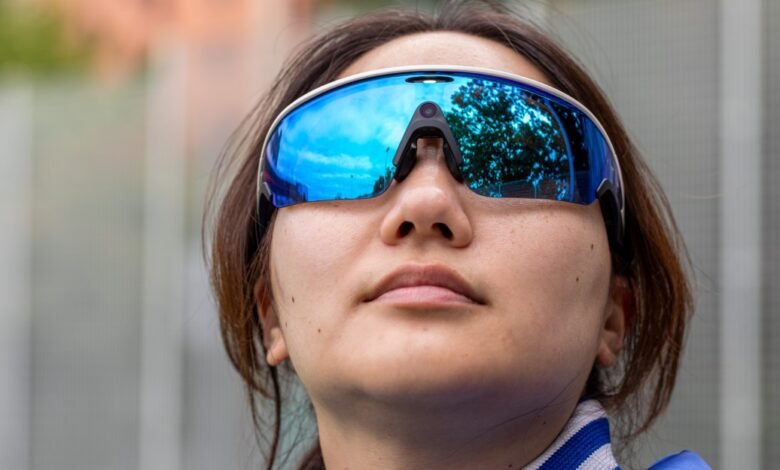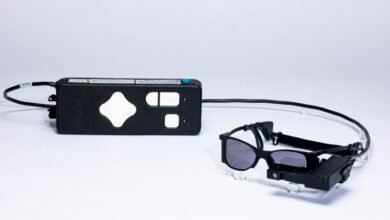Oakley Meta Vanguard: The Ultimate Smart Glasses for Active Lifestyles

▼ Summary
– The Oakley Meta Vanguard smart glasses feature a bold wraparound design with swappable polarized lenses, open-ear speakers, and a 12MP camera on the nose bridge for a centered first-person view.
– They are designed for athletes with features like impressive image stabilization, multiple video modes including Hyperlapse and slow motion, and an IP67 water and dust resistance rating.
– Battery life is 9 hours on a single charge, but recording video while listening to music significantly drains the battery, using 30% in a 30-minute run.
– The glasses integrate with Garmin and Strava to add stat overlays to media and signal workout goal achievement via an LED light, and include an auto-capture feature for recording at set points.
– They are tailored for outdoor sports use, with a snug fit for active wear, programmable buttons for easy control, and are not intended for everyday casual wear due to their distinctive look.
Stepping into the world of the Oakley Meta Vanguard smart glasses feels like suiting up for an athletic adventure. These high-tech shades are built for people who live life on the move, blending premium optics with powerful audio and a capable camera system. They’re not just another wearable; they’re a tool designed to enhance every run, ride, or outdoor session.
When I first put them on, I felt an instant transformation. Suddenly, I wasn’t just a tech reviewer, I was that determined coach on the sidelines, the weekend warrior chasing a personal best, or the confident athlete ready to take on any challenge. The bold, wraparound design makes a statement, with large polarized lenses that dominate your face. You’ll either look like a futuristic athlete or a character straight out of a sci-fi blockbuster. It’s a look that demands confidence, but for anyone serious about performance, the payoff is worth it.
The Prizm lenses are a standout feature, available in several tints to optimize vision for different environments. My blue lenses, for example, cut through glare on water and brightened greens and browns, making them ideal for fishing or trail running. Swapping lenses is simple, letting you adapt to changing light without missing a beat.
Weighing in at 66 grams, the Vanguard feels substantial but well-balanced. The snug fit kept them securely in place during jogs, and the adjustable nose pads ensured they didn’t slide down, even when I worked up a sweat. They’re also designed to work seamlessly with hats and helmets, a thoughtful touch for cyclists and runners alike.
Under the hood, the specs are impressive. You get open-ear speakers paired with a five-microphone array, Wi-Fi 6E and Bluetooth 5.3 connectivity, and a 12-megapixel camera positioned right in the center of the nose bridge. That placement gives a true first-person perspective, a clear improvement over earlier models that had off-center cameras. Video options range from 1080p to 3K, with solid image stabilization that keeps footage smooth even when you’re in motion.
Battery life is respectable, offering up to nine hours on a single charge or about six hours with continuous music playback. The case provides an extra 36 hours of power, and a quick 20-minute charge restores half the battery. Just keep in mind that recording video while streaming music drains power faster, on a 30-minute run with 20 minutes of filming, I used nearly a third of the battery.
Controls are located along the bottom of the right arm, including a programmable action button. You can use it to trigger Meta AI, start a Be My Eyes call, message a contact, or jump into one of the specialized capture modes. While the buttons are easy to locate by touch, I found them tricky to press accurately while running. Voice commands often worked better when I was on the go.
New video modes like Hyperlapse and slow-motion add creative flexibility. Hyperlapse condenses an entire activity into a short, dynamic clip, perfect for sharing a scenic route. Slow motion shines in action sports, whether you’re catching air on a snowboard or filming your pet’s energetic antics.
Integration with Garmin and Strava will appeal to data-driven athletes. Pairing a compatible Garmin device lets you overlay stats on your videos or set target goals like specific heart rate zones. A small LED on the inside hinge signals whether you’re hitting your targets, flashing red if you drift outside the zone. It’s a clever feature, though setting it up requires using Garmin’s workout builder, which may not suit everyone’s routine.
Another smart addition is auto-capture, which starts recording at predefined points, like every mile or just before a finish line. It’s a battery-friendly way to document key moments without constantly tapping buttons.
You can also ask Meta AI for workout stats mid-run, though glancing at a connected watch is often quicker. AI-generated summaries of your activities are available in the app, but they tend to feel generic, offering little beyond what your tracker already shows.
Even if you ignore the camera, the Vanguard works well as a pair of open-ear headphones. The audio is about 6 decibels louder than standard Ray-Ban smart glasses, a welcome boost when running near traffic. The IP67 rating means they can handle rain and dust, and during a windy walk, they held up well, even if the audio struggled against the gusts.
Let’s be clear: the Oakley Meta Vanguard isn’t for everyone. Its design is unapologetically sporty, and you won’t see people wearing these to a café unless they’re headed straight to the trails. But for runners, cyclists, and outdoor enthusiasts, these glasses deliver where it counts. They combine serious performance with smart features tailored to active use.
As someone who mourned the demise of the Bose Frames Tempo, I see the Vanguard as a worthy successor. It refines the concept of sports-focused smart glasses, offering better integration, improved capture, and that unmistakable Oakley aesthetic. If you’re ready to embrace your inner athlete, jabroni vibes and all, these might just become your go-to gear.
(Source: The Verge)





